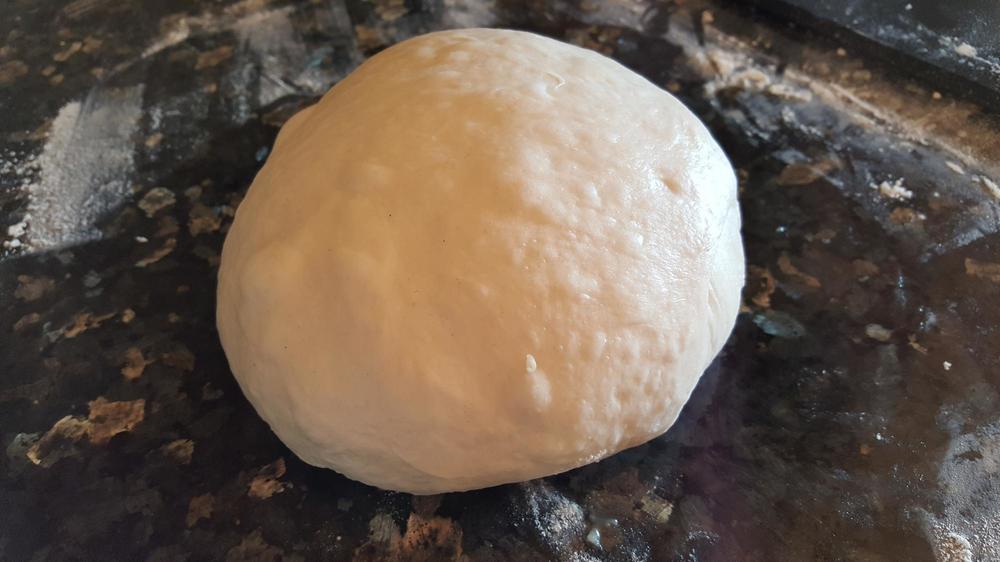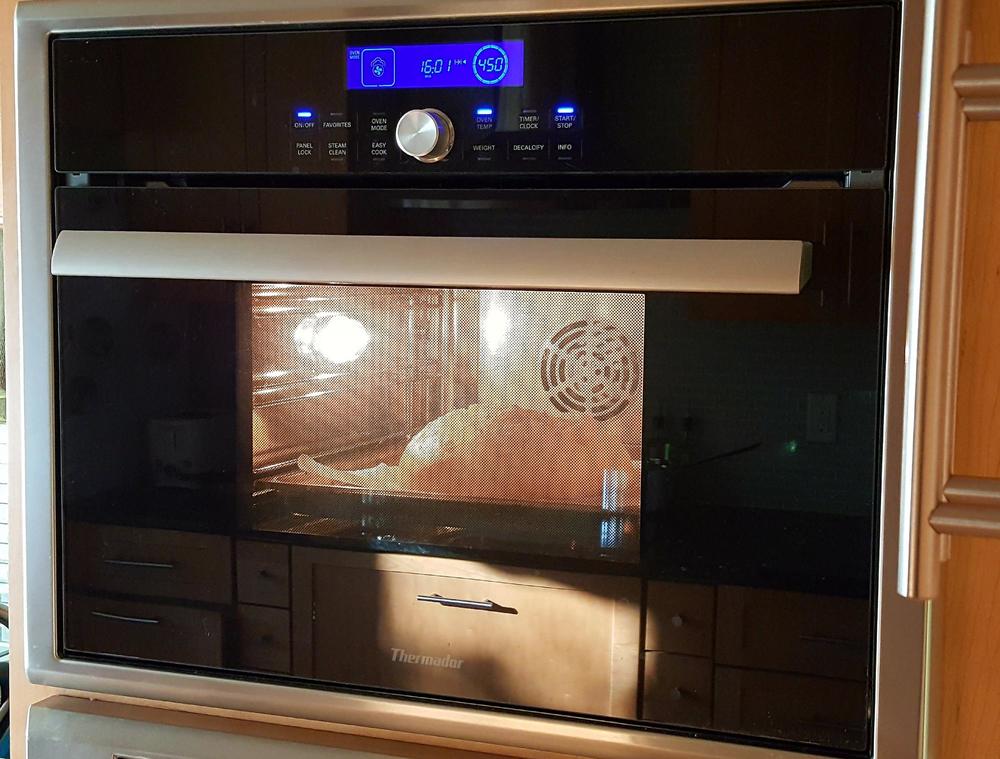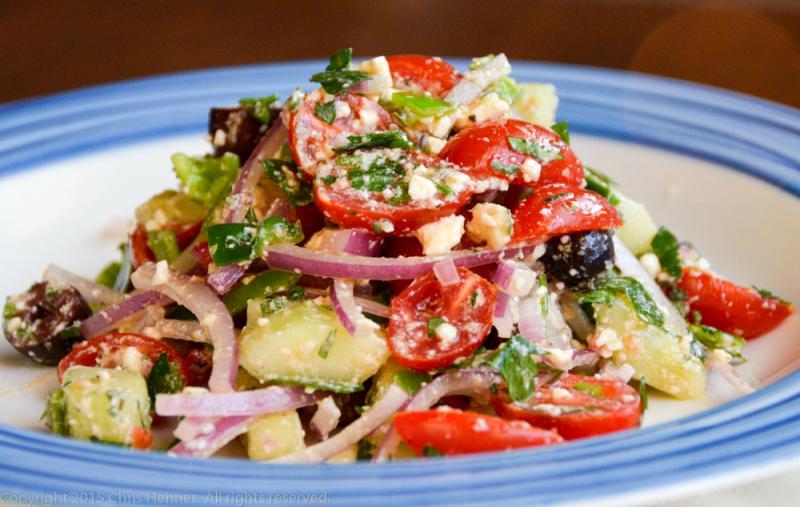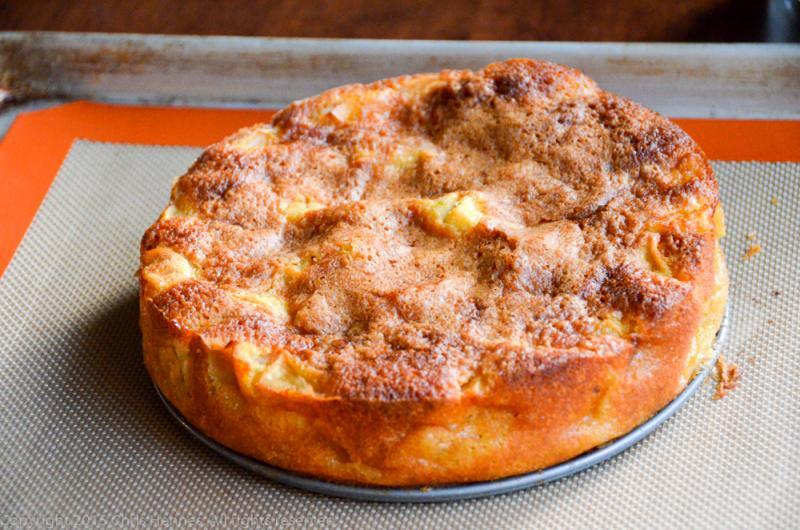Search the Community
Showing results for tags 'Cookbook'.
-
A few weeks ago I checked out a copy of Madhur Jaffrey's Vegetarian India from the library, and it is well on its way to earning a permanent place in my collection. I've really enjoyed the recipes I've cooked from it so far, and thought I'd share a few of them here. Of course, if anyone else has cooked anything from the book please share your favorites here, too. To kick things off, something that appears in nearly every meal I've cooked this month... a yogurt dish such as Simple Seasoned Yogurt, South Indian-Style (p. 324)
- 95 replies
-
- 8
-

-
- Vegetarian
- Indian
-
(and 1 more)
Tagged with:
-
I used my homemade toffee in a cookie recipe hoping that the toffee will add a crunch to the cookie... it didn't turn out well as the toffee melted and didn't keep its hardened crunch form. How can I prevent my toffee from melting in my cookie recipe?
-
- Troubleshooting
- Cake
-
(and 2 more)
Tagged with:
-
We have a local Italian bakery my mom loves, but they are very expensive and hard for her to get to. She also really likes cookbooks (she reads them even if she never cooks from them ) so I was thinking for her birthday I could get her a cookbook that has similar cookies and cakes, and offer to make a few things for her on request also. I'll obviously look myself, but eGullet is always well informed about the quality of cookbooks so I wanted to know if anyone has any recommendations. The thing about the Italian bakery is that the stuff they make seems to me to be not as sweet as classic American recipes, and often have more complex flavors and also are usually on the light end for whatever the item is. (Like even something that's intended to be dense doesn't have a very heavy sensation in the mouth.)
-
Is there a discussion in the book about the purpose of adding ascorbic acid? I just saw the contest #2 in which the recipe called for it. I'm curious because a woman I know on the internet used to work in a bakery in Vietnam, and said that to get similar results to the banh mi there, you need to add ascorbic acid. Does it act as a gluten relaxer? Traditional banh mi have a very tender and crisp crust, and a very light and tender, relatively closed crumb.
-
HOST'S NOTE: This post and those that follow were split off from the pre-release discussion of Modernist Bread. ***** Figured I don't need to dump all this into the contest thread - so I'll post here. My journey to making my first MC loaf. Her's the poolish after >12 hours: Not pictured - water with yeast in it below the bread flour and poolish That went into the mixer and not long later I had a shaggy mass: That rested for a while - then mixed until medium gluten formation - a window pane that was both opaque and translucent (no picture for that slightly messy part) Folded and rested, folded and rested, I think this is 1/2 the mass now ready to rest one final time. Proofed it in the oven - I have a picture of that but it's just foggy window oven Then it went into the oven, here it is at max temp - 450 with steam turned on. Completed loaf: \ And the crumb - this is awesome bread:
-
I got my copy of Eleven Madison Park: The Next-Chapter earlier this year and have enjoyed reading through it several times. As a result, I have been considering getting the version published in 2011 for Christmas, however, I am not sure if it is a duplicate of the recipe book included with the next chapter set. So I am wondering if somebody has access to both if they would be able to advise me whether the recipes are duplicated between the two books.
-
Solid intermediate cook, here. Not especially intimidated by elaborate preps. But I'm new to SV, and would like a recommendation for a cookbook for guidance and exploration. I was thinking of Tom Keller's Under Pressure, but I'm wondering if the preps he includes may not be the most generally useful. What do you all like, and why? Thanks!
-
On Nov. 7, 2017, Modernist Bread will finally arrive on my doorstep. Having preordered it literally the first day it was available, to say I'm excited about this book is a bit of an understatement. The team at The Cooking Lab have been gracious enough to give @Dave the Cook and me early electronic access to the book and so I've spent the last week pouring over it. I'm just going to start with a few initial comments here (it's 2600 pages long, so a full review is going to take some time, and require a bunch of baking!). Dave and I would also be happy to answer any questions you've got. One of the main things I've noticed about this book is a change in tone from the original Modernist Cuisine. It comes across as less "everything you know is wrong" and more "eighty bazillion other bakers have contributed to this knowledge and here's our synthesis of it." I don't think it's an exaggeration to say that Myhrvold and company are now the most experienced bread-bakers in the world. Not necessarily in terms of the number of identical loaves they've produced, but in the shear number of different recipes and techniques they've tried and the care with which they've analyzed the results. These volumes are a distillation of 100,000 years of human breadmaking experience, topped off with a dose of the Modernist ethos of taking what we know to the next level. The recipes include weight, volume, and baker's percentages, and almost all of them can be made by both a home baker and someone baking in a commercial facility. The home baker might need to compromise on shape (e.g. you can't fit a full-length baguette in most home ovens) but the book provides clear instructions for both the amateur and professional. The recipes are almost entirely concentrated in volumes 4 and 5, with very few in the other volumes (in contrast to Modernist Cuisine, where there were many recipes scattered throughout). I can't wait for the physical volumes to arrive so that I can have multiple volumes open at once, the recipes cross-reference techniques taught earlier quite frequently.
- 171 replies
-
- 11
-

-
Greetings, I've cooked several recipes from Keller's "Bouchon" the last couple of weeks, and have loved them all! At the moment (as in right this minute) I'm making the boeuf Bourguignon, and am a little confused about the red wine reduction. After reducing the wine, herbs, and veg for nearly an hour now, I'm nowhere near the consistancy of a glaze that Keller specifies. In fact, it looks mostly like the veg is on the receiving end of most of it. Is this how the recipe is meant to be? Can anybody tell me what kind of yield is expected? Any help would be appreciated. Thank you, kindly.
- 4 replies
-
- Cookbook
- Troubleshooting
-
(and 1 more)
Tagged with:
-
This unfortunately titled book changed my life. I always enjoyed cooking and idealized Julia Child & Jacque Pepin. But I was a typical home cook. I would see a recipe and try to duplicate it little understanding about what I was doing. Cooking the Nouvelle Cuisine in America talked about a philosophy of cooking. It showed me that there is more depth to cooking. A history. A philosophy. The recipes are very approachable and you can make them on a budget from grocery store ingredients. I read it as a grad student in Oregon, in the late 80's I had access to lots of fresh ingredients. And some very nice wines, cheap! I was suppose to be studying physics but I end up learning more about wine & cooking.
-
Here is the discussion thread. Here is the Amazon link. My first recipe was Mushroom Mapo Tofu p. 132 I was blown away by how good this tasted. Very spicy! Very authentic. I didn't miss the meat at all. I told Mr. Smokey I'd add ground pork next time and he said it didn't need it. Mr. Smokey refused pork? Ha! Definitely a keeper and maybe a regular rotation spot. If I had anything negative to say, it would be the dish wasn't very filling. The recipe is suppose to serve four but the two of us finished it off, no problem, and Mister wasn't full afterwards. A soup, or an appetizer could be paired with the dish to make a heartier meal. Note: I did receive a complimentary copy of the book to review, but all opinions of the book and recipes are mine.
-
Started in on Rob's book tonight. Nice pictures, interesting philosophy. The bit about grapevines reminded me ever so much about my balcony. My grapevine has been growing ten or twenty years, planted by the birds. Never a grape, ever. Only recently did I learn that unlike European grapes, the native grapevines are sexual. This one is undoubtedly a boy. He provides lovely leaves and shade, and something for the tomatoes to hang onto.
-
Those of us that have been following Rob Connoley's (aka gfron1) trek from home cook to down-and-literally-dirty locavore James Beard-semi-finalist chef are justifiably proud of his well-deserved transformation to a published author, which he has faithfully detailed in an earlier topic. If you're not familiar with his story, I urge you to catch up, then come back here, because we're ready to move on to the next step. Rob's book, Acorns & Cattails: A Modern Foraging Cookbook of Forest, Farm & Field, is finally, officially available. This alone is awesome news, and you should totally order your copy today. Or . . . . . . we want to continue the conversation about Rob, his book and his future plans in this topic. And just to up the awesomeness, Rob is offering a free book to a randomly selected participant here. Simply post a question or comment in this topic between now and 11:59 p.m. CST (US), 13 September 2016 and you'll be eligible to "win," based on a random drawing to be conducted, with each participant getting one chance, not including Society volunteers (and Rob himself. Multiple posts will not improve your chances, so don't get overheated.) The winner will be announced on 14 September. Rob will be along shortly to add his encouragement and whatever late-breaking news he has -- he's busy guy these days, so be patient -- but there's no need to wait to post questions or comments. P.S. And if you don't win, you should still get this book.
-
While not a new cookbook by any means, I haven't really had time to dig into this one until now. We've previously discussed the recipes in Jerusalem: A Cookbook, but not much has been said about Plenty. So, here goes... Chickpea saute with Greek yogurt (p. 211) This was a great way to kick off my time with this book. The flavors were outstanding, particularly the use of the caraway seeds and lemon juice. I used freshly-cooked Rancho Gordo chickpeas, which of course helps! The recipe was not totally trivial, but considering the flavors developed, if you don't count the time to cook the chickpeas it came together very quickly. I highly recommend this dish.
-
I'm hearing rumours of a new book from Fuchsia Dunlop, this time on Zhejiang cuisine from the east of China around Hangzhou and Ningbo, south of Shanghai. No date or title - or confirmation yet.
-
I'm making the citron cream recipe in Migoya's Elements of Desserts (p318/9?). It says to cook the anglaise to 85 degrees, place on an ice bath then whip the anglaise. I've done that but it doesn't seem to whip (let alone to a medium peak). This is a new technique I've not tried before so I'm at a loss. Anyone have any ideas?
-
I have been searching and searching for Jean-Pierre Wybauw's book: Chocolates 2: Ganache: Great Ganache Experience. I can't find a copy anywhere. Does anyone know if it is even still in print? I believe it was only published in 2010. It is (to my understanding) one of the definitive books of ganache formulation and recipe creation. I have his 4th book ,but this one eludes me. Any thoughts on where I might find a copy? My local library doesn't have it and brick and morter book stores are few and far between these days.
-
I know that there were similar threads, but I'm mostly interested in what kind of software or apps do you use for storing different kinds of recipes. For example, for most text and image based recipes I (like most people here) use Evernote. The notebooks-style organization works well, especially once you start using the Evernote Web Clipper. My browser (Citrio) can download videos, so video recipes are downloaded directly to the OneDrive folder on my PC and synced with the cloud. Very convenient, actually. At last, I'm currently testing the Asparagus android app. I might eventually move from Evernote to this one as it's more convenient for the quick references (though has no web clipper). What do you use for text, images and video recipes?
-
A friend gifted me a book written by someone I know of but only loosely. The acquaintance is a former missionary who has lived in Oaxaca for 15 years and co-authored this book with Susana Trilling (famous Oaxacan cooking instructor). The book is self published and really surprised me with its quality. The whole thesis is saving the indigenous foods of the area and combatting GMO infiltration of the area. Those of you who know the area might know of one of my hero restaurants - the like-minded Itanoni in Oaxaca City - surely they all travel in the same circles. Recipes are average fare - not fancy - clearly recipes from regular local folk, but very authentic, not fusion. They start with basic fresh masa, run you through all sorts of things including molé and salads and end up with stuff like yucca and egg tacos. The chapters include: Wild Greens (purslane, amaranth, etc), Beans & Squash, Salsa, Nopal and Maguey, Food and Fiesta, Medicinal uses. About 300 pages in all (so figure 150 in English and 150 in Spanish). This book is not available through Amazon. It is bilingual. I highly recommend it. Side note: Quite frankly these guys are goofs. They don't know how important and well produced this book is and aren't marketing it worth crap. Go buy it. Tell them I sent you. And enjoy this book. HERE
-
I know several people around these parts have picked up a copy of J. Kenji López-Alt's The Food Lab, so I figured it was time to start cooking from it. Chopped Greek Salad (p. 836) This is an excellent rendition of Greek Salad, with great proportions of the various ingredients, and just the right amount of dressing. There's nothing Earth-shattering here, but it gets me off on a good foot with this cookbook.
-
I got Food52 Genius Recipes a couple weeks ago, and this is the first thing I've cooked from the print version... Marie-Hélène’s Apple Cake Dorie Greenspan Available here I think this recipe actually appears in Around my French Table, too. It's an excellent apple cake, particularly interesting in that it doesn't have any spices in it. It is dense with apples, with just enough cake batter to hold everything together. Aesthetically it's a challenge to slice when it's warm, so I suggest letting it cool, then slicing, then reheating if you want it warm.
-
Has anyone else picked up a copy of Lesley Téllez's new cookbook, Eat Mexico? I've long wanted to take a culinary tour of Mexico City, but I still haven't made it down there; this book is doing nothing to calm that desire! There are quite a few ingredients in it that I am going to have a hard time getting my hands on, but I thought I'd give some of the recipes a try anyway. Is anyone else cooking from it yet?
-
Hello! I'm not sure if the "cookbook" section of the forum is the best choice for this post, but... I recent was gifted "Dry-Curing Pork" by Hector Kent - a purely self serving gift from my boyfriend, I might add! I'm going to make the coppiette this weekend, and his instructions for slicing the loin are a bit vague to me. He directs to slice it in "... 3/4 inch strips at least 8 inches long." Do you suppose the 3/4" dimension refer to thickness of the slice (ie the smallest of 3 dimensions), or might he mean thinner slices that are 3/4" wide? Misinterpreting this would really change the cure/dry time... Am I making sense? Thoughts? And for fun, here's my report on my first attempt at his bacon recipe (among other things). Um... wow! http://operaflute.blogspot.com/2015/06/when-time-is-on-your-side-bacon-and.html Thanks!
-
Has anyone else been reading this? I just finished the first time through and was impressed by the quality of the book, although many of the recipes might be a bit too southern for my taste. One recipe that I hope to try is green goddess dressing, p 36. The photography is beautiful, and I appreciated the section on okra as I have five okra plants growing on my balcony, which passes for my garden. I have deep respect for Satterfield and any author who is not too lazy to write out v-e-g-e-t-a-b-l-e-s.
-
I have a centrifuge and have been working my way though some of the recipes that benefit or require a centrifuge. Also have a similar carbonation set up as the one that is mentioned in the book and will be getting to the carbonation section next. Anyone else experimenting with this James Beard award winning cocktail book?



















